Detailed Report on Specific Needs of Health and Social Care Customers
VerifiedAdded on 2020/07/23
|11
|3271
|149
Report
AI Summary
This report examines the specific needs of customers in health and social care, focusing on individuals with conditions such as Cerebral Palsy and those with brain injuries and stroke-related disabilities. It explores the concepts of health, disability, illness, and behavior, and analyzes how these factors influence the needs of service users. The report also investigates the impact of legislation, social policies, society, and culture on the types of services provided. It delves into various intervention strategies to support people with specific needs, evaluating their effectiveness and potential impact of emerging developments. Furthermore, the report addresses challenging behaviors, their impact on health and social care organizations, and strategies for managing them. The analysis includes case studies and references to relevant literature to support the findings.
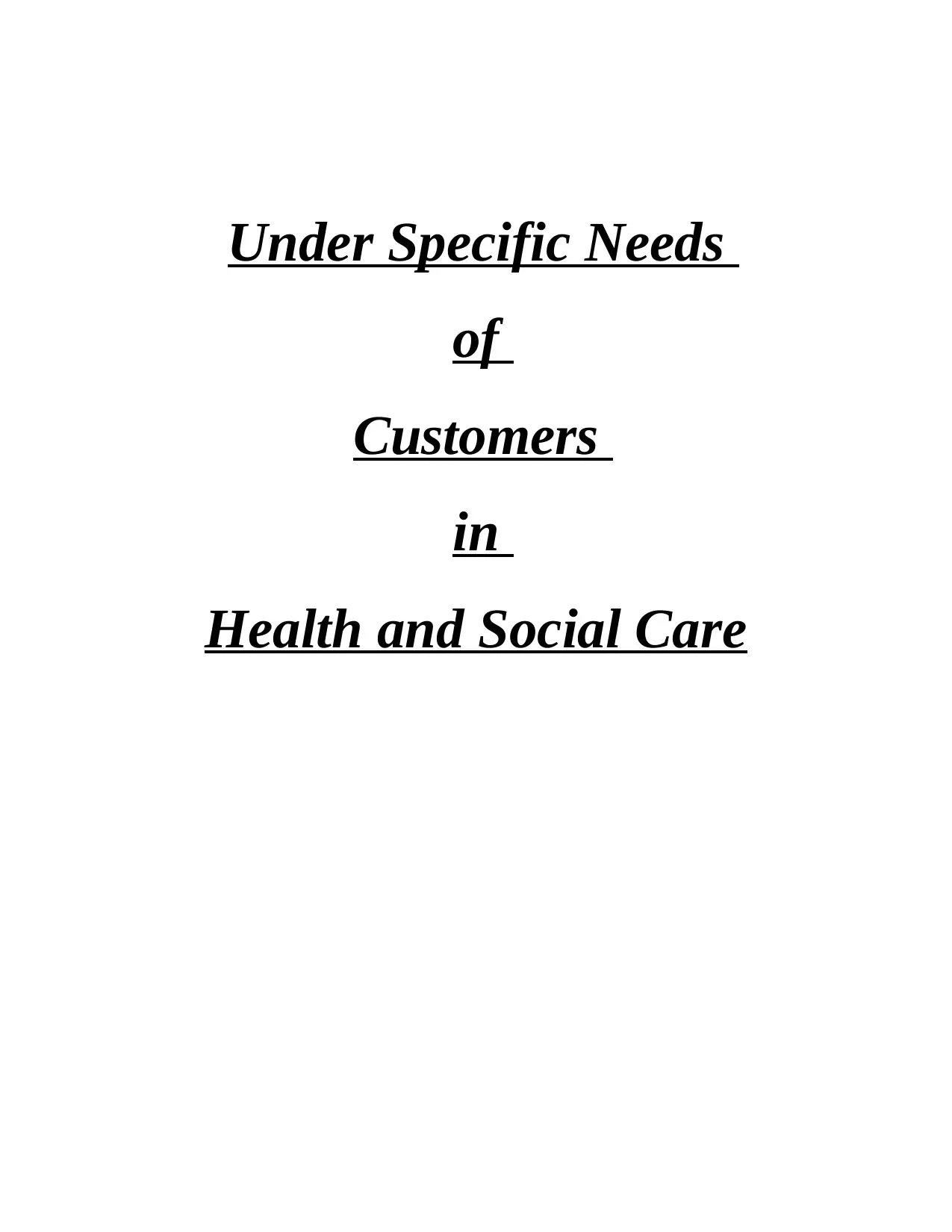
Under Specific Needs
of
Customers
in
Health and Social Care
of
Customers
in
Health and Social Care
Paraphrase This Document
Need a fresh take? Get an instant paraphrase of this document with our AI Paraphraser

Table of Contents
INTRODUCTION...........................................................................................................................1
TASK 1............................................................................................................................................1
1.1 Concept of health, disability, illness and behaviour for it's users.........................................1
1.2 Perception of change in specific needs.................................................................................1
1.3 Effect of legislation, social policies, society and culture on type of service ........................2
TASK 2............................................................................................................................................2
Covered in brochure....................................................................................................................2
TASK 3............................................................................................................................................2
3.1 Different types of approaches and interventions to support for people with specific needs.2
3.2 Effectiveness of intervention strategies................................................................................3
3.3 Potential impact of emerging development...........................................................................3
TASK 4............................................................................................................................................4
4.1 Different concepts of challenging behaviour:.......................................................................4
4.2 the potential impact of challenging behaviour on health and social care organisations......5
4.3 Different strategies for working with challenging behaviour ..............................................5
CONCLUSION ...............................................................................................................................6
REFERENCES................................................................................................................................7
INTRODUCTION...........................................................................................................................1
TASK 1............................................................................................................................................1
1.1 Concept of health, disability, illness and behaviour for it's users.........................................1
1.2 Perception of change in specific needs.................................................................................1
1.3 Effect of legislation, social policies, society and culture on type of service ........................2
TASK 2............................................................................................................................................2
Covered in brochure....................................................................................................................2
TASK 3............................................................................................................................................2
3.1 Different types of approaches and interventions to support for people with specific needs.2
3.2 Effectiveness of intervention strategies................................................................................3
3.3 Potential impact of emerging development...........................................................................3
TASK 4............................................................................................................................................4
4.1 Different concepts of challenging behaviour:.......................................................................4
4.2 the potential impact of challenging behaviour on health and social care organisations......5
4.3 Different strategies for working with challenging behaviour ..............................................5
CONCLUSION ...............................................................................................................................6
REFERENCES................................................................................................................................7

⊘ This is a preview!⊘
Do you want full access?
Subscribe today to unlock all pages.

Trusted by 1+ million students worldwide
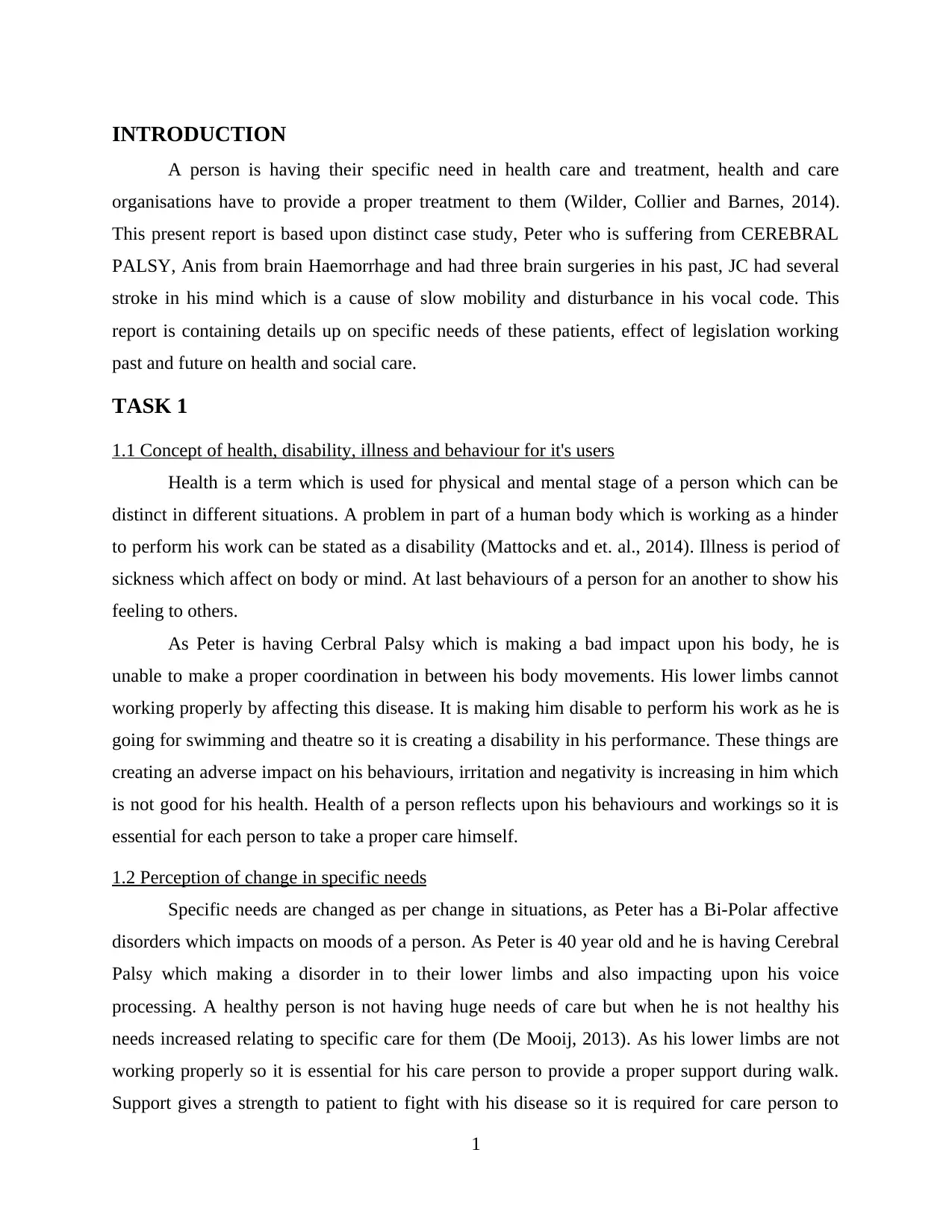
INTRODUCTION
A person is having their specific need in health care and treatment, health and care
organisations have to provide a proper treatment to them (Wilder, Collier and Barnes, 2014).
This present report is based upon distinct case study, Peter who is suffering from CEREBRAL
PALSY, Anis from brain Haemorrhage and had three brain surgeries in his past, JC had several
stroke in his mind which is a cause of slow mobility and disturbance in his vocal code. This
report is containing details up on specific needs of these patients, effect of legislation working
past and future on health and social care.
TASK 1
1.1 Concept of health, disability, illness and behaviour for it's users
Health is a term which is used for physical and mental stage of a person which can be
distinct in different situations. A problem in part of a human body which is working as a hinder
to perform his work can be stated as a disability (Mattocks and et. al., 2014). Illness is period of
sickness which affect on body or mind. At last behaviours of a person for an another to show his
feeling to others.
As Peter is having Cerbral Palsy which is making a bad impact upon his body, he is
unable to make a proper coordination in between his body movements. His lower limbs cannot
working properly by affecting this disease. It is making him disable to perform his work as he is
going for swimming and theatre so it is creating a disability in his performance. These things are
creating an adverse impact on his behaviours, irritation and negativity is increasing in him which
is not good for his health. Health of a person reflects upon his behaviours and workings so it is
essential for each person to take a proper care himself.
1.2 Perception of change in specific needs
Specific needs are changed as per change in situations, as Peter has a Bi-Polar affective
disorders which impacts on moods of a person. As Peter is 40 year old and he is having Cerebral
Palsy which making a disorder in to their lower limbs and also impacting upon his voice
processing. A healthy person is not having huge needs of care but when he is not healthy his
needs increased relating to specific care for them (De Mooij, 2013). As his lower limbs are not
working properly so it is essential for his care person to provide a proper support during walk.
Support gives a strength to patient to fight with his disease so it is required for care person to
1
A person is having their specific need in health care and treatment, health and care
organisations have to provide a proper treatment to them (Wilder, Collier and Barnes, 2014).
This present report is based upon distinct case study, Peter who is suffering from CEREBRAL
PALSY, Anis from brain Haemorrhage and had three brain surgeries in his past, JC had several
stroke in his mind which is a cause of slow mobility and disturbance in his vocal code. This
report is containing details up on specific needs of these patients, effect of legislation working
past and future on health and social care.
TASK 1
1.1 Concept of health, disability, illness and behaviour for it's users
Health is a term which is used for physical and mental stage of a person which can be
distinct in different situations. A problem in part of a human body which is working as a hinder
to perform his work can be stated as a disability (Mattocks and et. al., 2014). Illness is period of
sickness which affect on body or mind. At last behaviours of a person for an another to show his
feeling to others.
As Peter is having Cerbral Palsy which is making a bad impact upon his body, he is
unable to make a proper coordination in between his body movements. His lower limbs cannot
working properly by affecting this disease. It is making him disable to perform his work as he is
going for swimming and theatre so it is creating a disability in his performance. These things are
creating an adverse impact on his behaviours, irritation and negativity is increasing in him which
is not good for his health. Health of a person reflects upon his behaviours and workings so it is
essential for each person to take a proper care himself.
1.2 Perception of change in specific needs
Specific needs are changed as per change in situations, as Peter has a Bi-Polar affective
disorders which impacts on moods of a person. As Peter is 40 year old and he is having Cerebral
Palsy which making a disorder in to their lower limbs and also impacting upon his voice
processing. A healthy person is not having huge needs of care but when he is not healthy his
needs increased relating to specific care for them (De Mooij, 2013). As his lower limbs are not
working properly so it is essential for his care person to provide a proper support during walk.
Support gives a strength to patient to fight with his disease so it is required for care person to
1
Paraphrase This Document
Need a fresh take? Get an instant paraphrase of this document with our AI Paraphraser

work better with their patient like: Peter. Bi-Polar impact is making an adverse impact on their
moods so it is essential for their relatives to make a positive environment where he can feel
better. Mood swings creates a rudeness in his behaviours so it is essential for his care persons to
make a better service and care to him.
1.3 Effect of legislation, social policies, society and culture on type of service
British legislation has made many types of acts which impacts up on safeguarding of
adults, here they are:
Safeguarding Vulnerable Groups 2006: According to this act it is required for health and
social care organisation to recruit a person who haves all qualifications and experience to
perform a better work for patients (DePoy and Gitlin, 2015). Organisations has to make a regular
analysis of medical care person to improve their workings. This act has made a huge impact
upon health and social care organisation and as well as on patients like: Peter which needs a
specific care.
Social policies: These are having huge impact on patients, according to the Health and Social
Care Act, 2012, organisation working in this sector are liable to provide a better services to it
users and NHS is accountable for any type of faults. Monitoring of these organisation are making
them better coordinated to provide a better service.
Society and cultural impact: Social and cultural is creating a huge impact on persons which are
having a need of special care. Supporting nature of society crates a positive impacts on persons
like: Peter.
So in a concluded way, these all policies are creating valuable services for Peter and
making a better results for his needs.
TASK 2
Covered in brochure
TASK 3
3.1 Different types of approaches and interventions to support for people with specific needs
People suffering from critical disease are having huge need of special care so it is
essential for health and care organisation to provide a better treatment to them. As HL was
suffering from disabilities regarding to speak his feels to others and reacts on actions of others so
2
moods so it is essential for their relatives to make a positive environment where he can feel
better. Mood swings creates a rudeness in his behaviours so it is essential for his care persons to
make a better service and care to him.
1.3 Effect of legislation, social policies, society and culture on type of service
British legislation has made many types of acts which impacts up on safeguarding of
adults, here they are:
Safeguarding Vulnerable Groups 2006: According to this act it is required for health and
social care organisation to recruit a person who haves all qualifications and experience to
perform a better work for patients (DePoy and Gitlin, 2015). Organisations has to make a regular
analysis of medical care person to improve their workings. This act has made a huge impact
upon health and social care organisation and as well as on patients like: Peter which needs a
specific care.
Social policies: These are having huge impact on patients, according to the Health and Social
Care Act, 2012, organisation working in this sector are liable to provide a better services to it
users and NHS is accountable for any type of faults. Monitoring of these organisation are making
them better coordinated to provide a better service.
Society and cultural impact: Social and cultural is creating a huge impact on persons which are
having a need of special care. Supporting nature of society crates a positive impacts on persons
like: Peter.
So in a concluded way, these all policies are creating valuable services for Peter and
making a better results for his needs.
TASK 2
Covered in brochure
TASK 3
3.1 Different types of approaches and interventions to support for people with specific needs
People suffering from critical disease are having huge need of special care so it is
essential for health and care organisation to provide a better treatment to them. As HL was
suffering from disabilities regarding to speak his feels to others and reacts on actions of others so
2
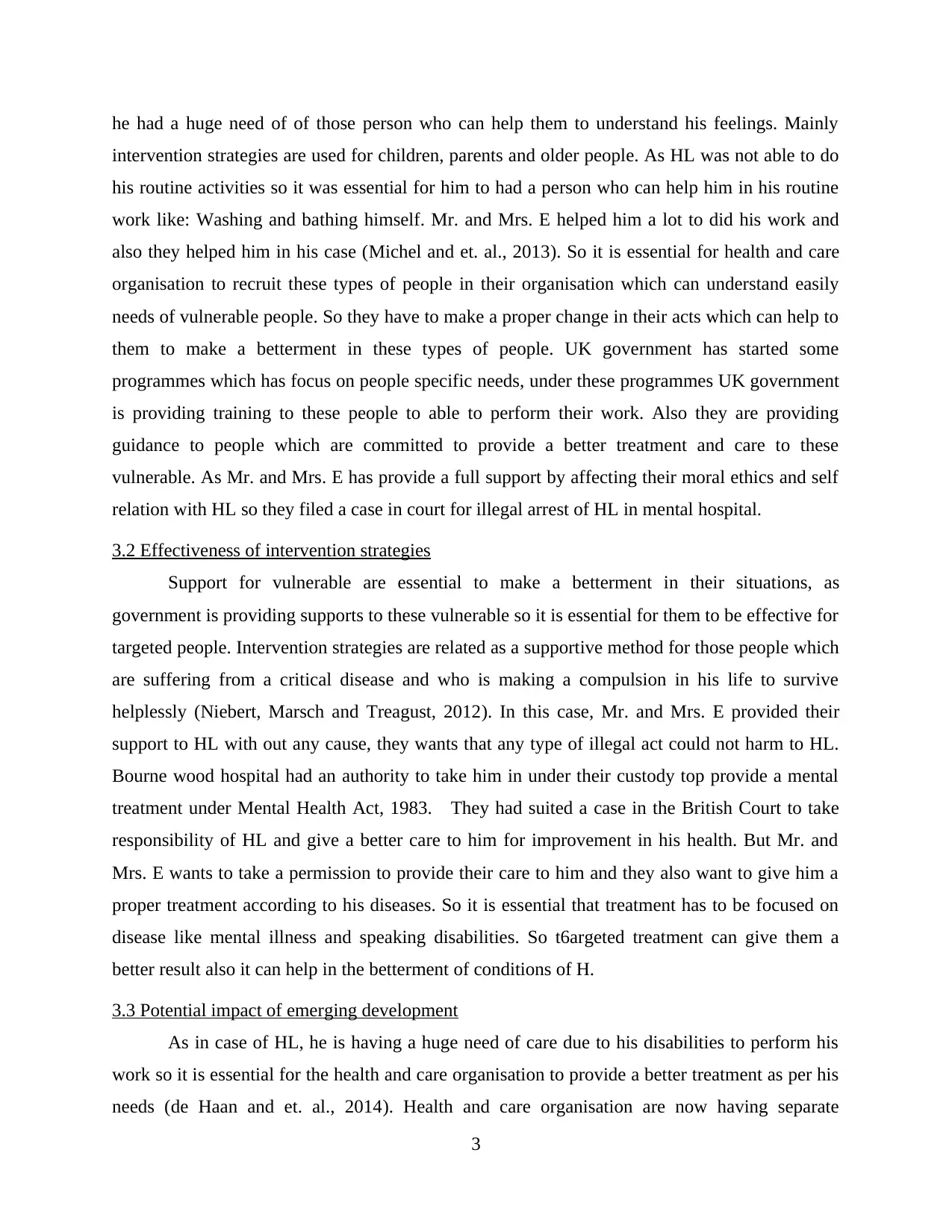
he had a huge need of of those person who can help them to understand his feelings. Mainly
intervention strategies are used for children, parents and older people. As HL was not able to do
his routine activities so it was essential for him to had a person who can help him in his routine
work like: Washing and bathing himself. Mr. and Mrs. E helped him a lot to did his work and
also they helped him in his case (Michel and et. al., 2013). So it is essential for health and care
organisation to recruit these types of people in their organisation which can understand easily
needs of vulnerable people. So they have to make a proper change in their acts which can help to
them to make a betterment in these types of people. UK government has started some
programmes which has focus on people specific needs, under these programmes UK government
is providing training to these people to able to perform their work. Also they are providing
guidance to people which are committed to provide a better treatment and care to these
vulnerable. As Mr. and Mrs. E has provide a full support by affecting their moral ethics and self
relation with HL so they filed a case in court for illegal arrest of HL in mental hospital.
3.2 Effectiveness of intervention strategies
Support for vulnerable are essential to make a betterment in their situations, as
government is providing supports to these vulnerable so it is essential for them to be effective for
targeted people. Intervention strategies are related as a supportive method for those people which
are suffering from a critical disease and who is making a compulsion in his life to survive
helplessly (Niebert, Marsch and Treagust, 2012). In this case, Mr. and Mrs. E provided their
support to HL with out any cause, they wants that any type of illegal act could not harm to HL.
Bourne wood hospital had an authority to take him in under their custody top provide a mental
treatment under Mental Health Act, 1983. They had suited a case in the British Court to take
responsibility of HL and give a better care to him for improvement in his health. But Mr. and
Mrs. E wants to take a permission to provide their care to him and they also want to give him a
proper treatment according to his diseases. So it is essential that treatment has to be focused on
disease like mental illness and speaking disabilities. So t6argeted treatment can give them a
better result also it can help in the betterment of conditions of H.
3.3 Potential impact of emerging development
As in case of HL, he is having a huge need of care due to his disabilities to perform his
work so it is essential for the health and care organisation to provide a better treatment as per his
needs (de Haan and et. al., 2014). Health and care organisation are now having separate
3
intervention strategies are used for children, parents and older people. As HL was not able to do
his routine activities so it was essential for him to had a person who can help him in his routine
work like: Washing and bathing himself. Mr. and Mrs. E helped him a lot to did his work and
also they helped him in his case (Michel and et. al., 2013). So it is essential for health and care
organisation to recruit these types of people in their organisation which can understand easily
needs of vulnerable people. So they have to make a proper change in their acts which can help to
them to make a betterment in these types of people. UK government has started some
programmes which has focus on people specific needs, under these programmes UK government
is providing training to these people to able to perform their work. Also they are providing
guidance to people which are committed to provide a better treatment and care to these
vulnerable. As Mr. and Mrs. E has provide a full support by affecting their moral ethics and self
relation with HL so they filed a case in court for illegal arrest of HL in mental hospital.
3.2 Effectiveness of intervention strategies
Support for vulnerable are essential to make a betterment in their situations, as
government is providing supports to these vulnerable so it is essential for them to be effective for
targeted people. Intervention strategies are related as a supportive method for those people which
are suffering from a critical disease and who is making a compulsion in his life to survive
helplessly (Niebert, Marsch and Treagust, 2012). In this case, Mr. and Mrs. E provided their
support to HL with out any cause, they wants that any type of illegal act could not harm to HL.
Bourne wood hospital had an authority to take him in under their custody top provide a mental
treatment under Mental Health Act, 1983. They had suited a case in the British Court to take
responsibility of HL and give a better care to him for improvement in his health. But Mr. and
Mrs. E wants to take a permission to provide their care to him and they also want to give him a
proper treatment according to his diseases. So it is essential that treatment has to be focused on
disease like mental illness and speaking disabilities. So t6argeted treatment can give them a
better result also it can help in the betterment of conditions of H.
3.3 Potential impact of emerging development
As in case of HL, he is having a huge need of care due to his disabilities to perform his
work so it is essential for the health and care organisation to provide a better treatment as per his
needs (de Haan and et. al., 2014). Health and care organisation are now having separate
3
⊘ This is a preview!⊘
Do you want full access?
Subscribe today to unlock all pages.

Trusted by 1+ million students worldwide
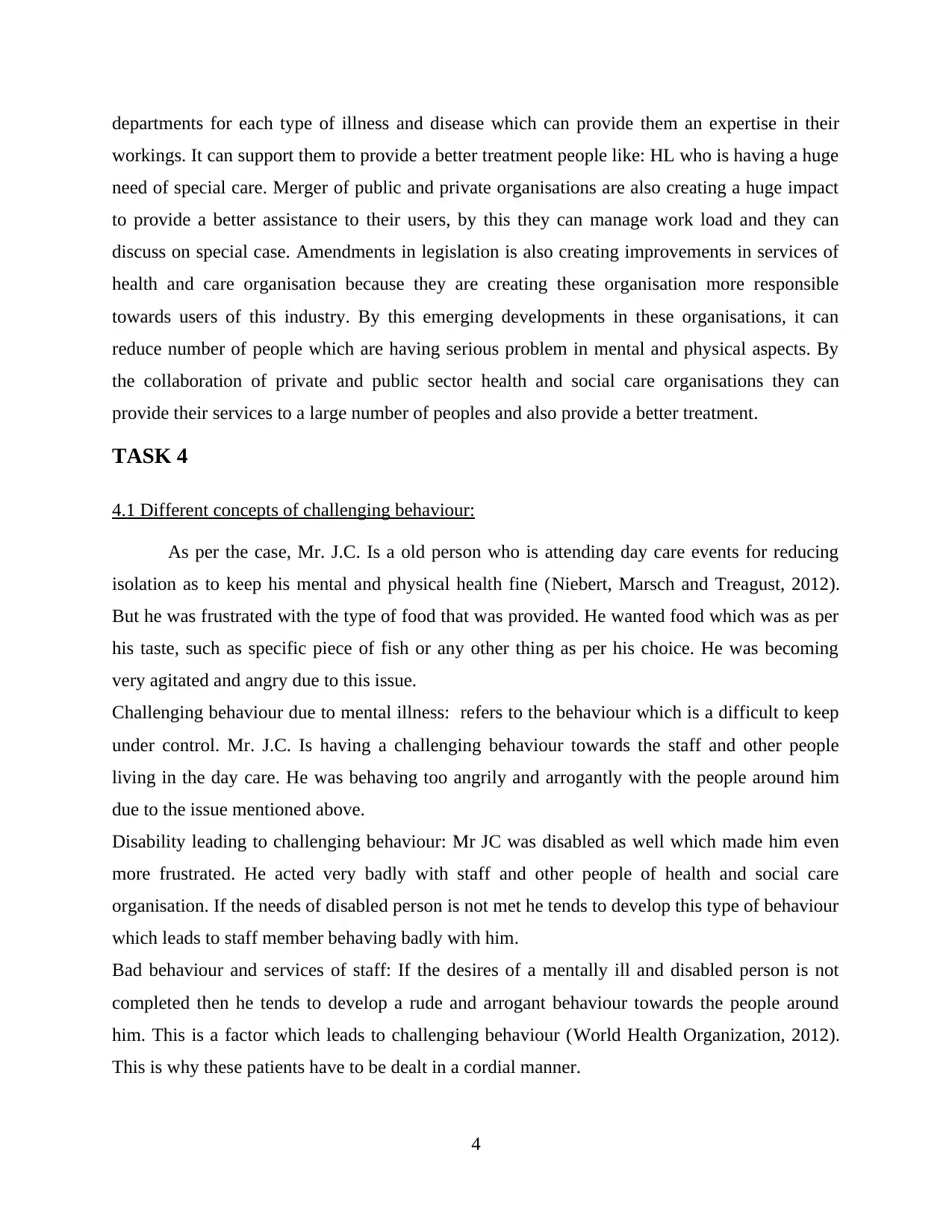
departments for each type of illness and disease which can provide them an expertise in their
workings. It can support them to provide a better treatment people like: HL who is having a huge
need of special care. Merger of public and private organisations are also creating a huge impact
to provide a better assistance to their users, by this they can manage work load and they can
discuss on special case. Amendments in legislation is also creating improvements in services of
health and care organisation because they are creating these organisation more responsible
towards users of this industry. By this emerging developments in these organisations, it can
reduce number of people which are having serious problem in mental and physical aspects. By
the collaboration of private and public sector health and social care organisations they can
provide their services to a large number of peoples and also provide a better treatment.
TASK 4
4.1 Different concepts of challenging behaviour:
As per the case, Mr. J.C. Is a old person who is attending day care events for reducing
isolation as to keep his mental and physical health fine (Niebert, Marsch and Treagust, 2012).
But he was frustrated with the type of food that was provided. He wanted food which was as per
his taste, such as specific piece of fish or any other thing as per his choice. He was becoming
very agitated and angry due to this issue.
Challenging behaviour due to mental illness: refers to the behaviour which is a difficult to keep
under control. Mr. J.C. Is having a challenging behaviour towards the staff and other people
living in the day care. He was behaving too angrily and arrogantly with the people around him
due to the issue mentioned above.
Disability leading to challenging behaviour: Mr JC was disabled as well which made him even
more frustrated. He acted very badly with staff and other people of health and social care
organisation. If the needs of disabled person is not met he tends to develop this type of behaviour
which leads to staff member behaving badly with him.
Bad behaviour and services of staff: If the desires of a mentally ill and disabled person is not
completed then he tends to develop a rude and arrogant behaviour towards the people around
him. This is a factor which leads to challenging behaviour (World Health Organization, 2012).
This is why these patients have to be dealt in a cordial manner.
4
workings. It can support them to provide a better treatment people like: HL who is having a huge
need of special care. Merger of public and private organisations are also creating a huge impact
to provide a better assistance to their users, by this they can manage work load and they can
discuss on special case. Amendments in legislation is also creating improvements in services of
health and care organisation because they are creating these organisation more responsible
towards users of this industry. By this emerging developments in these organisations, it can
reduce number of people which are having serious problem in mental and physical aspects. By
the collaboration of private and public sector health and social care organisations they can
provide their services to a large number of peoples and also provide a better treatment.
TASK 4
4.1 Different concepts of challenging behaviour:
As per the case, Mr. J.C. Is a old person who is attending day care events for reducing
isolation as to keep his mental and physical health fine (Niebert, Marsch and Treagust, 2012).
But he was frustrated with the type of food that was provided. He wanted food which was as per
his taste, such as specific piece of fish or any other thing as per his choice. He was becoming
very agitated and angry due to this issue.
Challenging behaviour due to mental illness: refers to the behaviour which is a difficult to keep
under control. Mr. J.C. Is having a challenging behaviour towards the staff and other people
living in the day care. He was behaving too angrily and arrogantly with the people around him
due to the issue mentioned above.
Disability leading to challenging behaviour: Mr JC was disabled as well which made him even
more frustrated. He acted very badly with staff and other people of health and social care
organisation. If the needs of disabled person is not met he tends to develop this type of behaviour
which leads to staff member behaving badly with him.
Bad behaviour and services of staff: If the desires of a mentally ill and disabled person is not
completed then he tends to develop a rude and arrogant behaviour towards the people around
him. This is a factor which leads to challenging behaviour (World Health Organization, 2012).
This is why these patients have to be dealt in a cordial manner.
4
Paraphrase This Document
Need a fresh take? Get an instant paraphrase of this document with our AI Paraphraser
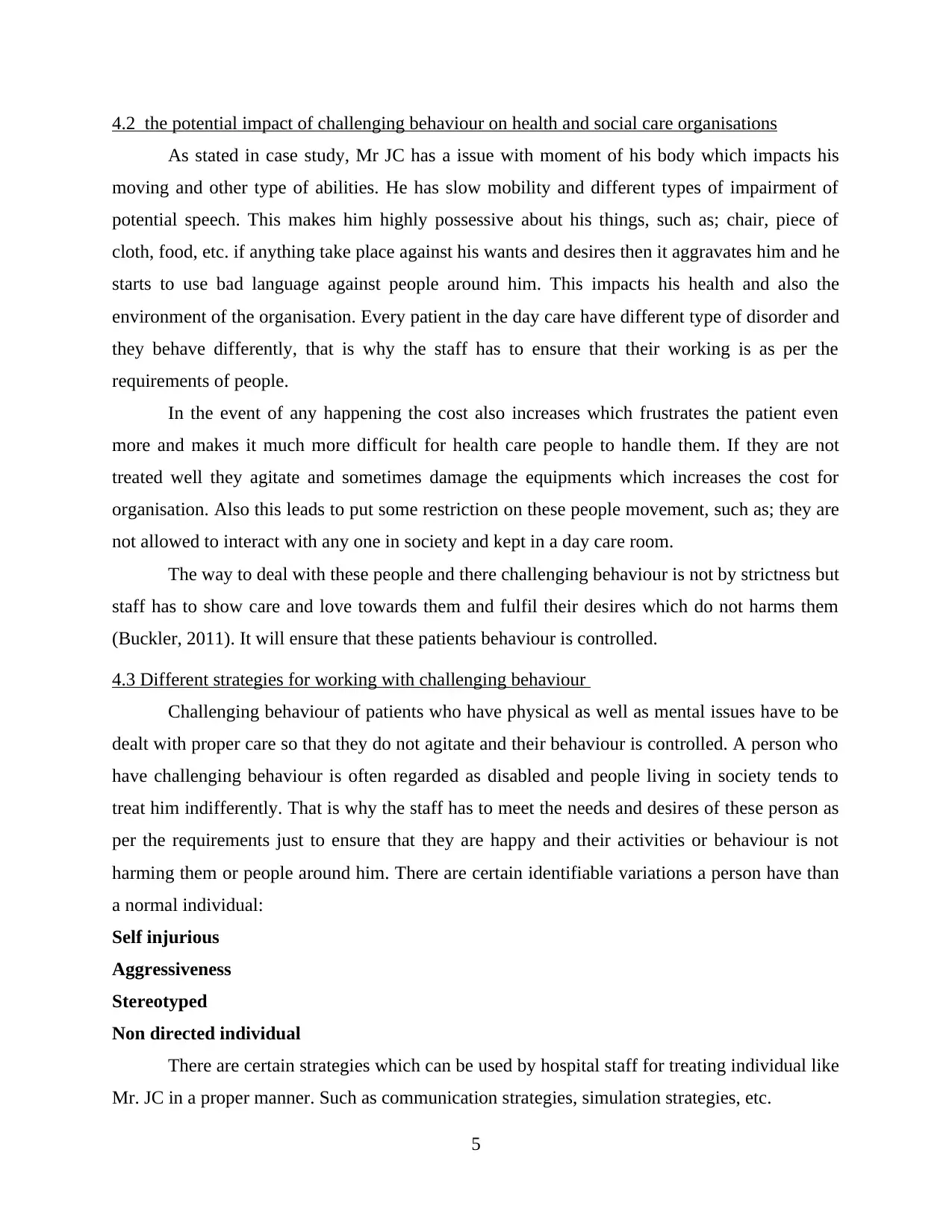
4.2 the potential impact of challenging behaviour on health and social care organisations
As stated in case study, Mr JC has a issue with moment of his body which impacts his
moving and other type of abilities. He has slow mobility and different types of impairment of
potential speech. This makes him highly possessive about his things, such as; chair, piece of
cloth, food, etc. if anything take place against his wants and desires then it aggravates him and he
starts to use bad language against people around him. This impacts his health and also the
environment of the organisation. Every patient in the day care have different type of disorder and
they behave differently, that is why the staff has to ensure that their working is as per the
requirements of people.
In the event of any happening the cost also increases which frustrates the patient even
more and makes it much more difficult for health care people to handle them. If they are not
treated well they agitate and sometimes damage the equipments which increases the cost for
organisation. Also this leads to put some restriction on these people movement, such as; they are
not allowed to interact with any one in society and kept in a day care room.
The way to deal with these people and there challenging behaviour is not by strictness but
staff has to show care and love towards them and fulfil their desires which do not harms them
(Buckler, 2011). It will ensure that these patients behaviour is controlled.
4.3 Different strategies for working with challenging behaviour
Challenging behaviour of patients who have physical as well as mental issues have to be
dealt with proper care so that they do not agitate and their behaviour is controlled. A person who
have challenging behaviour is often regarded as disabled and people living in society tends to
treat him indifferently. That is why the staff has to meet the needs and desires of these person as
per the requirements just to ensure that they are happy and their activities or behaviour is not
harming them or people around him. There are certain identifiable variations a person have than
a normal individual:
Self injurious
Aggressiveness
Stereotyped
Non directed individual
There are certain strategies which can be used by hospital staff for treating individual like
Mr. JC in a proper manner. Such as communication strategies, simulation strategies, etc.
5
As stated in case study, Mr JC has a issue with moment of his body which impacts his
moving and other type of abilities. He has slow mobility and different types of impairment of
potential speech. This makes him highly possessive about his things, such as; chair, piece of
cloth, food, etc. if anything take place against his wants and desires then it aggravates him and he
starts to use bad language against people around him. This impacts his health and also the
environment of the organisation. Every patient in the day care have different type of disorder and
they behave differently, that is why the staff has to ensure that their working is as per the
requirements of people.
In the event of any happening the cost also increases which frustrates the patient even
more and makes it much more difficult for health care people to handle them. If they are not
treated well they agitate and sometimes damage the equipments which increases the cost for
organisation. Also this leads to put some restriction on these people movement, such as; they are
not allowed to interact with any one in society and kept in a day care room.
The way to deal with these people and there challenging behaviour is not by strictness but
staff has to show care and love towards them and fulfil their desires which do not harms them
(Buckler, 2011). It will ensure that these patients behaviour is controlled.
4.3 Different strategies for working with challenging behaviour
Challenging behaviour of patients who have physical as well as mental issues have to be
dealt with proper care so that they do not agitate and their behaviour is controlled. A person who
have challenging behaviour is often regarded as disabled and people living in society tends to
treat him indifferently. That is why the staff has to meet the needs and desires of these person as
per the requirements just to ensure that they are happy and their activities or behaviour is not
harming them or people around him. There are certain identifiable variations a person have than
a normal individual:
Self injurious
Aggressiveness
Stereotyped
Non directed individual
There are certain strategies which can be used by hospital staff for treating individual like
Mr. JC in a proper manner. Such as communication strategies, simulation strategies, etc.
5
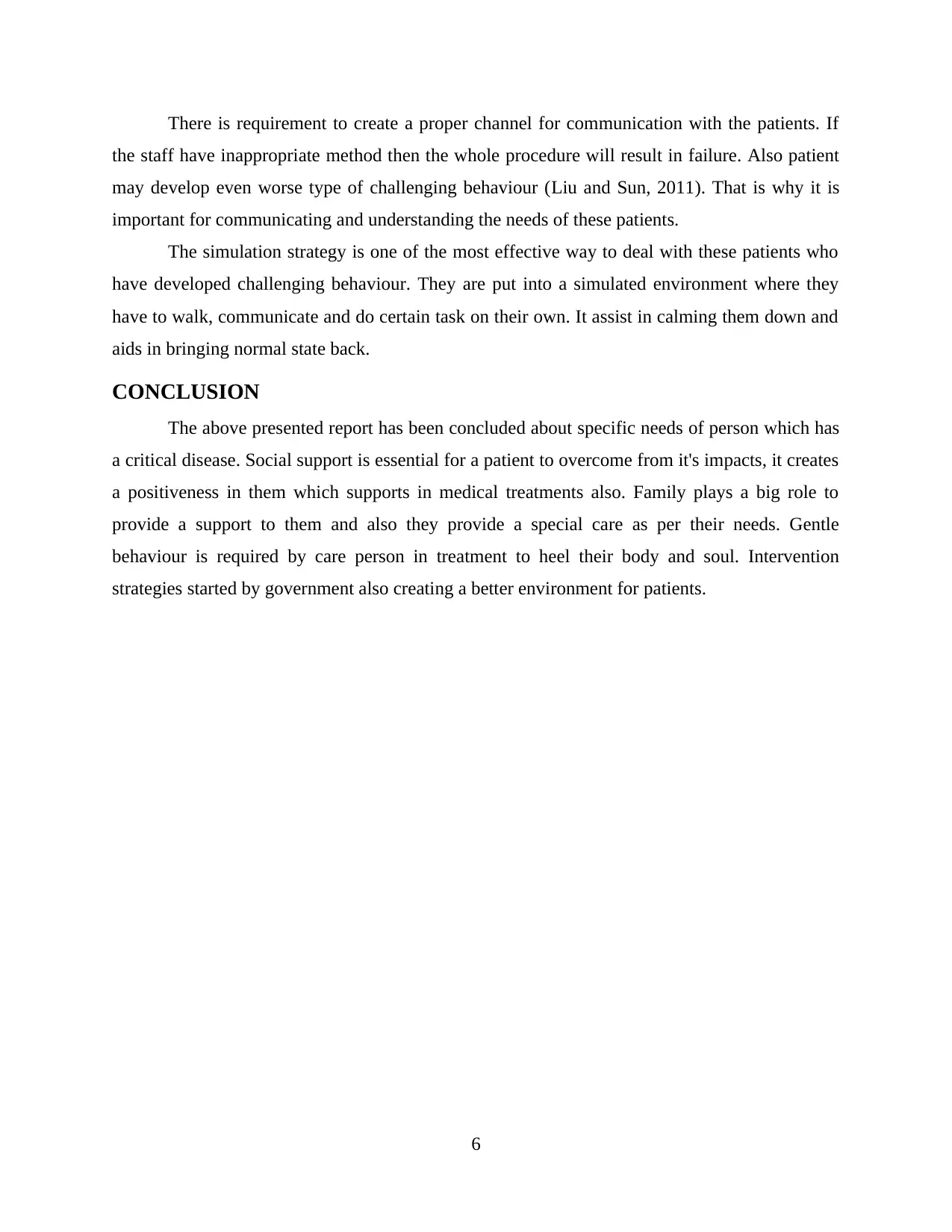
There is requirement to create a proper channel for communication with the patients. If
the staff have inappropriate method then the whole procedure will result in failure. Also patient
may develop even worse type of challenging behaviour (Liu and Sun, 2011). That is why it is
important for communicating and understanding the needs of these patients.
The simulation strategy is one of the most effective way to deal with these patients who
have developed challenging behaviour. They are put into a simulated environment where they
have to walk, communicate and do certain task on their own. It assist in calming them down and
aids in bringing normal state back.
CONCLUSION
The above presented report has been concluded about specific needs of person which has
a critical disease. Social support is essential for a patient to overcome from it's impacts, it creates
a positiveness in them which supports in medical treatments also. Family plays a big role to
provide a support to them and also they provide a special care as per their needs. Gentle
behaviour is required by care person in treatment to heel their body and soul. Intervention
strategies started by government also creating a better environment for patients.
6
the staff have inappropriate method then the whole procedure will result in failure. Also patient
may develop even worse type of challenging behaviour (Liu and Sun, 2011). That is why it is
important for communicating and understanding the needs of these patients.
The simulation strategy is one of the most effective way to deal with these patients who
have developed challenging behaviour. They are put into a simulated environment where they
have to walk, communicate and do certain task on their own. It assist in calming them down and
aids in bringing normal state back.
CONCLUSION
The above presented report has been concluded about specific needs of person which has
a critical disease. Social support is essential for a patient to overcome from it's impacts, it creates
a positiveness in them which supports in medical treatments also. Family plays a big role to
provide a support to them and also they provide a special care as per their needs. Gentle
behaviour is required by care person in treatment to heel their body and soul. Intervention
strategies started by government also creating a better environment for patients.
6
⊘ This is a preview!⊘
Do you want full access?
Subscribe today to unlock all pages.

Trusted by 1+ million students worldwide
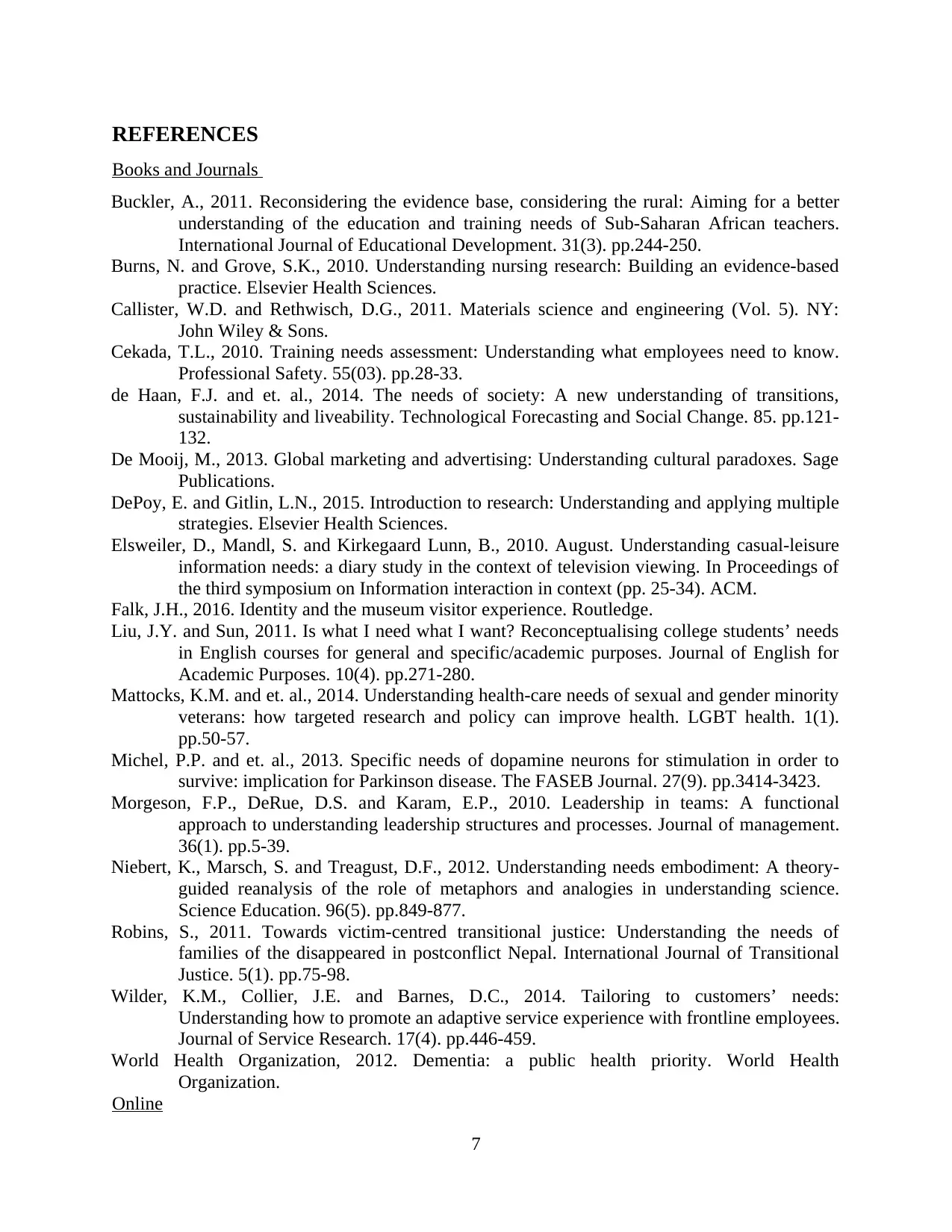
REFERENCES
Books and Journals
Buckler, A., 2011. Reconsidering the evidence base, considering the rural: Aiming for a better
understanding of the education and training needs of Sub-Saharan African teachers.
International Journal of Educational Development. 31(3). pp.244-250.
Burns, N. and Grove, S.K., 2010. Understanding nursing research: Building an evidence-based
practice. Elsevier Health Sciences.
Callister, W.D. and Rethwisch, D.G., 2011. Materials science and engineering (Vol. 5). NY:
John Wiley & Sons.
Cekada, T.L., 2010. Training needs assessment: Understanding what employees need to know.
Professional Safety. 55(03). pp.28-33.
de Haan, F.J. and et. al., 2014. The needs of society: A new understanding of transitions,
sustainability and liveability. Technological Forecasting and Social Change. 85. pp.121-
132.
De Mooij, M., 2013. Global marketing and advertising: Understanding cultural paradoxes. Sage
Publications.
DePoy, E. and Gitlin, L.N., 2015. Introduction to research: Understanding and applying multiple
strategies. Elsevier Health Sciences.
Elsweiler, D., Mandl, S. and Kirkegaard Lunn, B., 2010. August. Understanding casual-leisure
information needs: a diary study in the context of television viewing. In Proceedings of
the third symposium on Information interaction in context (pp. 25-34). ACM.
Falk, J.H., 2016. Identity and the museum visitor experience. Routledge.
Liu, J.Y. and Sun, 2011. Is what I need what I want? Reconceptualising college students’ needs
in English courses for general and specific/academic purposes. Journal of English for
Academic Purposes. 10(4). pp.271-280.
Mattocks, K.M. and et. al., 2014. Understanding health-care needs of sexual and gender minority
veterans: how targeted research and policy can improve health. LGBT health. 1(1).
pp.50-57.
Michel, P.P. and et. al., 2013. Specific needs of dopamine neurons for stimulation in order to
survive: implication for Parkinson disease. The FASEB Journal. 27(9). pp.3414-3423.
Morgeson, F.P., DeRue, D.S. and Karam, E.P., 2010. Leadership in teams: A functional
approach to understanding leadership structures and processes. Journal of management.
36(1). pp.5-39.
Niebert, K., Marsch, S. and Treagust, D.F., 2012. Understanding needs embodiment: A theory‐
guided reanalysis of the role of metaphors and analogies in understanding science.
Science Education. 96(5). pp.849-877.
Robins, S., 2011. Towards victim-centred transitional justice: Understanding the needs of
families of the disappeared in postconflict Nepal. International Journal of Transitional
Justice. 5(1). pp.75-98.
Wilder, K.M., Collier, J.E. and Barnes, D.C., 2014. Tailoring to customers’ needs:
Understanding how to promote an adaptive service experience with frontline employees.
Journal of Service Research. 17(4). pp.446-459.
World Health Organization, 2012. Dementia: a public health priority. World Health
Organization.
Online
7
Books and Journals
Buckler, A., 2011. Reconsidering the evidence base, considering the rural: Aiming for a better
understanding of the education and training needs of Sub-Saharan African teachers.
International Journal of Educational Development. 31(3). pp.244-250.
Burns, N. and Grove, S.K., 2010. Understanding nursing research: Building an evidence-based
practice. Elsevier Health Sciences.
Callister, W.D. and Rethwisch, D.G., 2011. Materials science and engineering (Vol. 5). NY:
John Wiley & Sons.
Cekada, T.L., 2010. Training needs assessment: Understanding what employees need to know.
Professional Safety. 55(03). pp.28-33.
de Haan, F.J. and et. al., 2014. The needs of society: A new understanding of transitions,
sustainability and liveability. Technological Forecasting and Social Change. 85. pp.121-
132.
De Mooij, M., 2013. Global marketing and advertising: Understanding cultural paradoxes. Sage
Publications.
DePoy, E. and Gitlin, L.N., 2015. Introduction to research: Understanding and applying multiple
strategies. Elsevier Health Sciences.
Elsweiler, D., Mandl, S. and Kirkegaard Lunn, B., 2010. August. Understanding casual-leisure
information needs: a diary study in the context of television viewing. In Proceedings of
the third symposium on Information interaction in context (pp. 25-34). ACM.
Falk, J.H., 2016. Identity and the museum visitor experience. Routledge.
Liu, J.Y. and Sun, 2011. Is what I need what I want? Reconceptualising college students’ needs
in English courses for general and specific/academic purposes. Journal of English for
Academic Purposes. 10(4). pp.271-280.
Mattocks, K.M. and et. al., 2014. Understanding health-care needs of sexual and gender minority
veterans: how targeted research and policy can improve health. LGBT health. 1(1).
pp.50-57.
Michel, P.P. and et. al., 2013. Specific needs of dopamine neurons for stimulation in order to
survive: implication for Parkinson disease. The FASEB Journal. 27(9). pp.3414-3423.
Morgeson, F.P., DeRue, D.S. and Karam, E.P., 2010. Leadership in teams: A functional
approach to understanding leadership structures and processes. Journal of management.
36(1). pp.5-39.
Niebert, K., Marsch, S. and Treagust, D.F., 2012. Understanding needs embodiment: A theory‐
guided reanalysis of the role of metaphors and analogies in understanding science.
Science Education. 96(5). pp.849-877.
Robins, S., 2011. Towards victim-centred transitional justice: Understanding the needs of
families of the disappeared in postconflict Nepal. International Journal of Transitional
Justice. 5(1). pp.75-98.
Wilder, K.M., Collier, J.E. and Barnes, D.C., 2014. Tailoring to customers’ needs:
Understanding how to promote an adaptive service experience with frontline employees.
Journal of Service Research. 17(4). pp.446-459.
World Health Organization, 2012. Dementia: a public health priority. World Health
Organization.
Online
7
Paraphrase This Document
Need a fresh take? Get an instant paraphrase of this document with our AI Paraphraser

SAINT - Specific Approaches and INTerventions in day and community services for older
people with mental health needs. 2017 [Online]. Available through:
<https://www.nice.org.uk/sharedlearning/saint-specific-approaches-and-interventions-
in-day-and-community-services-for-older-people-with-mental-health-needs>. [Accessed
on 29 June 2017].
The Challenging Behaviour Foundation. 2017 [Online]. Available through:
<http://www.challengingbehaviour.org.uk/>. [Accessed on 29 June 2017].
8
people with mental health needs. 2017 [Online]. Available through:
<https://www.nice.org.uk/sharedlearning/saint-specific-approaches-and-interventions-
in-day-and-community-services-for-older-people-with-mental-health-needs>. [Accessed
on 29 June 2017].
The Challenging Behaviour Foundation. 2017 [Online]. Available through:
<http://www.challengingbehaviour.org.uk/>. [Accessed on 29 June 2017].
8
1 out of 11
Related Documents
Your All-in-One AI-Powered Toolkit for Academic Success.
+13062052269
info@desklib.com
Available 24*7 on WhatsApp / Email
![[object Object]](/_next/static/media/star-bottom.7253800d.svg)
Unlock your academic potential
Copyright © 2020–2025 A2Z Services. All Rights Reserved. Developed and managed by ZUCOL.





